WWE Ruthless Aggression Review: Securing The Future

The second season of WWE’s Ruthless Aggression documentary series has arrived and now it’s time to look at an episode called Securing The Future.
I reviewed the five episodes from the first season. You can find them at the bottom of this review.
Here’s the synopsis of this episode on WWE Network:
S2 | E5: Securing the Future
“The early stages of WWE’s developmental system in OVW, along with other unconventional experiments such as WWE Tough Enough, usher in a new generation of Superstars headlined by Brock Lesnar, John Cena, Batista, Randy Orton and The Miz.”
It’s listed as the fifth episode of this season, but the order doesn’t really matter. Let’s get to it.
===
The Ruthless Aggression series intro video aired. The narrator for season two is WWE Smackdown announcer Pat McAfee.
They showed the WWE Performance Center when Triple H introduced it in 2012 as a place to “train the future.”
It was back to 1997 with former OVW Promoter Jim Cornette talking about how in the late 1990s the development center was a ring at the TV studio in Stamford (WWE’s home city). Tom Prichard, a former WWE trainer, said that WCW had the Powerplant in place and WWE didn’t have anything like that. Cornette and Tom talked about how Dory Funk Jr. and Tom Prichard would work out wrestlers in the warehouse. The Rock was shown in his early days.
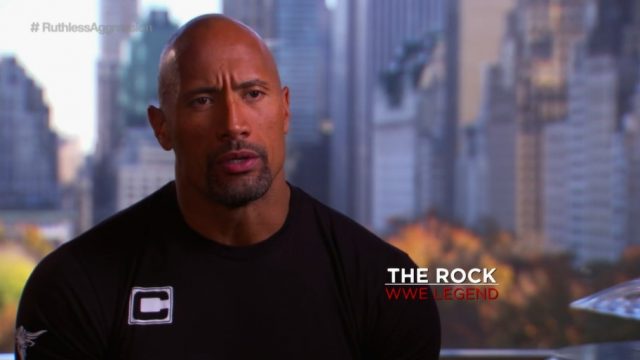
(I think that Rock interview is nearly a decade old now, but they got a lot out of it, so kudos to WWE for that.)
The Rock said he spent a lot of time in a ring in a warehouse with Tom Prichard. Rock said he appreciated the time and effort that Tom put in training him. Dory Funk Jr. said that Tom kept them disciplined and they paid attention to what they showed them in the ring. They showed images of young stars like Mark Henry, Edge, Christian and The Hardy Boys in the early training days. Crash Holly, Albert, Test and Val Venis were also shown.
Christian spoke about how they just had a couple of rings set up out there. Edge spoke about how once you got there, you could end up in the ring with people that could teach you. They showed Pat Patterson, Jerry Lawler, The Undertaker, Shawn Michaels and other legends speaking to the young talent to try to help them. Christian mentioned how Kurt Angle was there for his first week of training to be a WWE superstar.
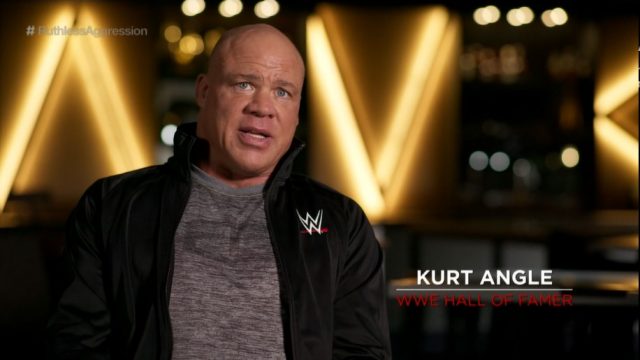
Kurt Angle said that he remembered the first day and how he wanted to quit. Angle said it felt so bad. Dory Funk said that Angle had so much natural skill, so Angle finished the camp and Angle said that it was difficult to do. It was stated that The Funkin’ Dojo wasn’t the ideal place to teach guys how to wrestle in front of a crowd.
Jim Cornette talked about how he felt that they needed to do this training on a more organized level. Cornette noted that Jim Ross (Head of Talent Relations at the time) was in favor of that. Cornette said they can train the crowd in front of different crowds because that’s how you learn. Bruce Prichard, current WWE Executive Director, spoke about how it was Jim Cornette’s brainchild for OVW to be development. Danny Davis owned OVW – he was a journeyman wrestler and was promoting in Louisville. Cornette said that OVW already had a school with live events in place and Cornette said he wanted to move from Connecticut back to Louisville. Cornette said that JR took the idea to Vince, who liked the idea and Cornette joked that Vince liked the idea of paying Cornette less. Cornette said they were told to try it for six months and that lasted eight years.
(From six months as a trial to eight years. I’d say that’s a great run!)
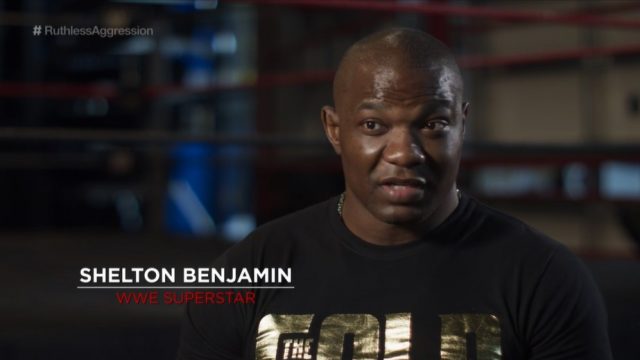
Shelton Benjamin spoke about how he never worked on the indies. Shelton went from college wrestling to professional wrestling. Shelton spoke about WCW’s Powerplant because he had heard about it. Batista said that the building was an abandoned warehouse. John Cena said that they built it to make a good TV show and they had a place to call their own as a locker room. Randy Orton wasn’t sure if he was in the right spot and he knocks on the door wondering if he was in the right place when Batista opened up. Orton said he was 19 years old wondering “what the f**k” he got himself into. Batista spoke about the incredible athletes they had like Shelton Benjamin, Brock Lesnar, John Cena and claimed that Randy Orton was all confused not knowing where to go (laughs).
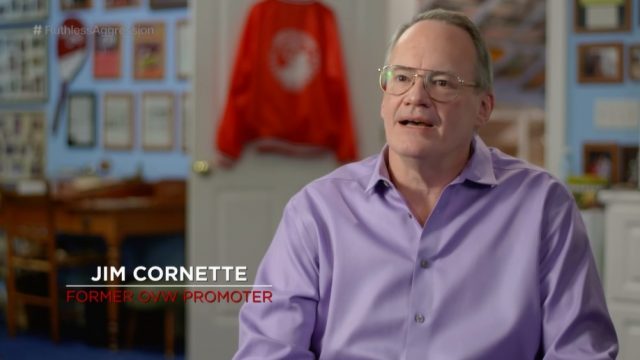
Cornette said that the best wrestling performer by far was Shelton Benjamin because he was the best athlete. Cornette said that Brock Lesnar was the most physically intimidating guy while John Cena looked like he could cut a promo like he’s been on TV for 15 years. Cornette spoke about how Lesnar and Benjamin couldn’t really talk at that point. Cornette said that Orton had it up in the head what wrestling is all about because of his father and grandfather. Cornette said that they all looked at Batista like “My God look at that guy.” Cornette said they tried to focus on the strong points of the talent and minimize the weaknesses.
(That’s always been a comment that wrestling bookers have used in the past. Focus on the positives and hide the negatives. It makes sense, of course.)
Cena talked about how the minds behind OVW were a wealth of information and they enjoyed giving back to people. Cena said that Cornette gave him a reading list as well as tapes to study. Cena said he got to work with people who were tremendously talented. Cornette said that one of the hardest things to learn is doing television, so they used the tapings a training ground because the guys had to learn how to be on television. Batista said that they all knew that they were a special group and there was a feeling they were the next era.
They also mentioned veterans that were in need of a fresh start. Big Show spoke about how he was sent down to the farm leagues to “grow up a bit.” Prichard said that Big Show put on weight because he wasn’t working a steady schedule, so he wasn’t taking care of himself properly. Cornette said that they put a bucket outside for Big Show, who would puke after doing drills and go back in the ring to work out more. Show said that OVW allowed him to reboot himself and find out what kind of talent he wanted to be.
Mark Henry said that when he went to OVW he felt like he was being punished, but it was the best thing that ever happened to him. Mark said he learned the psychology of the business and learned the why, when and how about the business. Bruce mentioned that The APA were in OVW to have some matches with guys there too while APA was rehabbing from injuries.
Brian Gewirtz – former WWE head writer from 2002 to 2012 – was shown talking about how the Monday Night Wars were over in 2001 when WWE bought WCW, so you couldn’t get talent from WCW or ECW. Brian said that they had to develop talent.
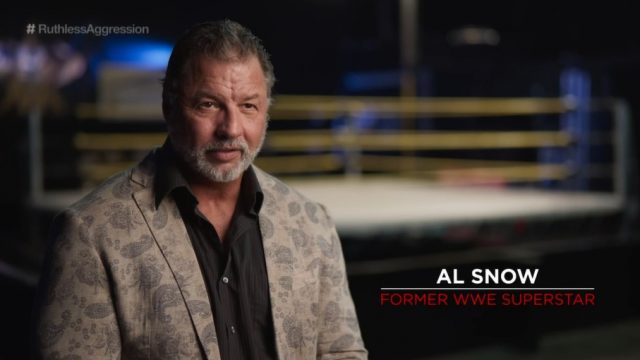
They were on to talking about the reality show Tough Enough with former WWE superstar Al Snow talking about how Kevin Dunn (WWE Executive Producer) approached him about it. Gewirtz said that it made sense to do something like that. Adam Cole said that he watched it as a kid and thought it was the coolest show. The Miz and Kurt Angle talked about how it gave people an opportunity. Johnny Gargano thought it was so cool to see wrestling on MTV. Snow said that everything on Tough Enough was real and they got to do what they wanted to do in terms of training those kids. Snow mentioned if you weren’t a wrestling fan then you got a new respect for it. Snow said that if you were a wrestling fan then it gave you that much joy.
The first two winners were Maven and Nidia as a highlight was shown of Maven eliminating The Undertaker in the 2002 Royal Rumble. It was stated that they were green, meaning not quite ready. They showed Chris Nowinski botching a promo and also Jackie Gayda making some mistakes during an infamous match with Jackie & Nowinski against Trish Stratus & Bradshaw. Adam Cole said that he was there and the fans were not happy. They showed some of the botched spots in the match. JBL said that the last thing you want to do is learn on national television.
(That Jackie/Nowinski vs. Trish/Bradshaw match is infamous due to how bad it is. Jackie messed up a bunch of stuff on a live Raw and it’s a miracle that they got through it.)
It was back to talking about the OVW standouts as we saw Brock Lesnar’s WWE TV debut on March 18, 2002. Angle talked about how Lesnar wasn’t just a great wrestler, he was a freak of nature that was ready to go. Randy Orton was up next on Smackdown and then Batista was “Deacon Batista” working with D-Von Dudley. John Cena’s debut was June 27, 2002 when he got into a match with Kurt Angle. Cena said that they gave him the words “Ruthless Aggression” to define the character. Shelton Benjamin debuted on December 26, 2002 with Paul Heyman announcing him (as well as Charlie Haas) and Shelton knew he was ready. Shelton said he couldn’t stop smiling because he was so happy and it was one of the best days of his life. Cena said that Lesnar, Orton, Batista, Benjamin and himself knew they were destined for greatness.
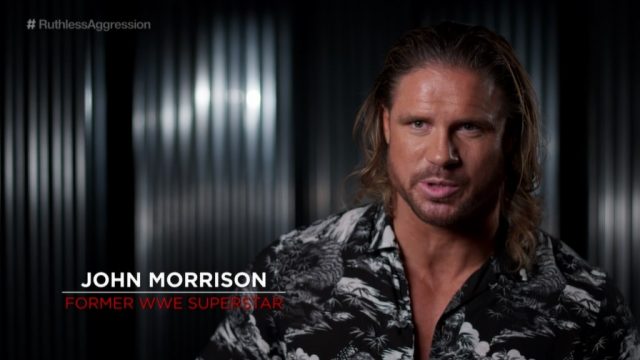
They showed more Tough Enough highlights showing how some superstars were born from being on that show. John Morrison (released by WWE earlier this month) was a Tough Enough 3 winner with Morrison saying that it was a great opportunity. Morrison said that Tough Enough opened the door for him and was a jumpstart of getting into the business. The Miz came from Tough Enough with Snow saying that he’s proud of the star that he became. Miz said that he had the desire, so sometimes you just need the chance. Miz said his shot was Tough Enough and he took that shot. Gewirtz said that they were getting TV time, so that’s important. Edge said how he didn’t care if people came from Tough Enough because John Morrison was a freak (in a good way) and it gave him more people to wrestle.
The original OVW guys were shown having success with Brock Lesnar main eventing his first WrestleMania at WM19 in 2003. Seth Rollins spoke about the incredible amount of talent at the same time. They showed Randy Orton winning his first World Title at SummerSlam 2004 and I am shocked that they showed a Chris Benoit clip, but that’s who Orton beat. Shelton Benjamin was shown winning the Intercontinental Title at Taboo Tuesday 2004. Miz said that crop from OVW showed that investing in development can lead to huge WWE superstars. Batista winning the World Title at WrestleMania 21 was shown and John Cena won his first WWE Title at that same WrestleMania 21 event.
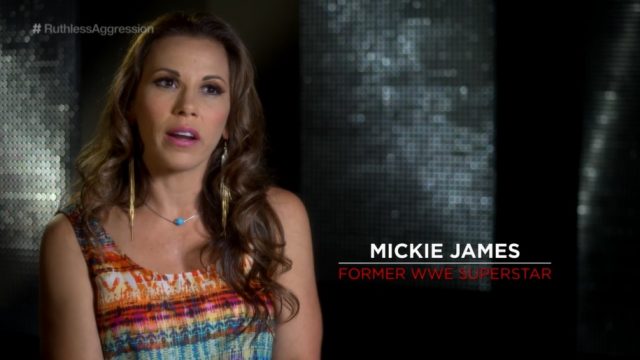
It was onto 2005 where a new crop of developmental emerged in OVW and they were eager to follow in their footsteps. Mickie James said it was a high bar set in OVW because she was watching how those guys became huge stars, so it was a lot of pressure. They showed clips of some guys and girls that would become huge stars over the years. Mickie said that she grew as an artist and performer. Mickie said that there was a brother and sisterhood since they were all learning together. Dolph Ziggler said that being in OVW was huge because you learned a lot instead of wandering around hoping you make it. Santino said that it was an incredible place because you gave people the tools to make their dreams come true. Santino said that if you look at the roster at that time, it was quite significant and it was an excellent program. Beth Phoenix was shown in action. Cornette talked about how talented of a group it was that came through OVW. Cornette said that it might have been ruthless and aggressive, but it wouldn’t have been Ruthless Aggression without the OVW class.
They also spoke about Deep South Wrestling in 2005 and Florida Championship Wrestling in 2007. It showed more highlights out of wrestlers that started in those places that would go on to be huge stars in WWE.
There was always a commitment to the future. They mentioned WrestleMania 27 in 2011 when the main event featured alums from Tough Enough (The Miz), OVW (John Cena) and the Stamford warehouse (The Rock). Rock said coming back at WM27 was so special. Cena said that working in OVW they would challenge themselves and make him believe he could work in front of a WrestleMania crowd. Miz said that there’s nothing like main eventing WrestleMania. Miz said that not everybody on a show can be captivating, entertaining and have that “It Factor.” Gewirtz spoke about how Cena and Miz evolved so much and obviously Rock being involved, so people in WWE were pointing at that as an example of the success of the developmental system.
(I get what they were saying by making that point, but that Miz/Cena match is one of the worst WrestleMania main events ever. I rated that Miz/Cena match at *1/2 out of five and I think that’s generous.)
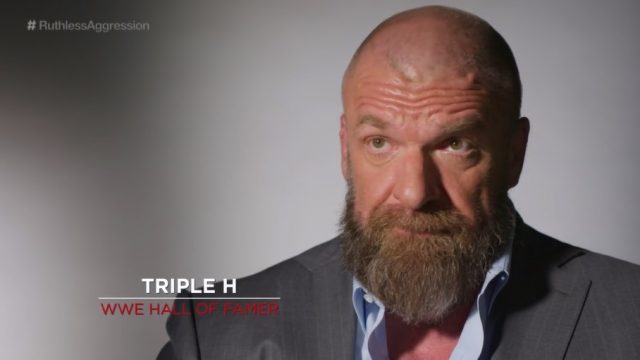
Triple H said that the next generation of talent is everything. Hunter said that over time you have a warehouse, then OVW doing what it needs to do, but while they were growing as a company, the thought was to create a system and program to entice people to want to be a part of it. They showed highlights of the WWE Performance Center showing wrestlers working out and training. Gewirtz talked about how much the development system had to evolve. Edge said that it had to evolve and said that you had to develop them. They showed some current WWE stars like Seth Rollins and Big E in development. Gargano said that you never know who is going to hit as a huge superstar.
Hunter said that in his generation, it was hard to find somebody to train you. Hunter said that now they are constantly building over a new talent at a young age. Hunter said that people grew up watching Steve Austin, The Rock and John Cena thinking “I have to do that.” It ended with a clip of Triple H at an NXT show saying: “The future is now.”
In the final moments, they showed images of a lot of great WWE superstars from their developmental years. That was it.
This episode has a runtime of 32:22.
Final Thoughts
I thought they did a nice job of covering the developmental process over the last 25 years since it goes back to the late 1990s in the warehouse. It was cool seeing some of the highlights of wrestlers training in the warehouse in Stamford with some of them becoming huge names while others faded away because it’s not that easy to make it in WWE.
Jim Cornette did a great job of explaining why they needed a training center of their own that allowed the wrestlers a chance to perform in front of fans. I also liked how they focused on the core five OVW guys Brock Lesnar, John Cena, Randy Orton, Batista and Shelton Benjamin. They all went on to become multiple-time World Champions in WWE except for Benjamin, but Shelton still has had a very successful and long career.
It was smart to include Tough Enough here while also interviewing Al Snow for it because that show was pivotal for WWE’s developmental future. Seeing guys like Johnny Gargano and Adam Cole (who are in their early to mid-30s now) talk about it shows how influential it was because they were in their teens back then. A show like Tough Enough may not have produced a bunch of Hall of Famers, but you never know how much influence it could have in terms of inspiring the superstars of the future.
Sometimes fans hate these documentaries because it’s WWE re-writing the past. I don’t think that’s the case here. They covered everything well and got the right people to tell interesting stories. I enjoyed it.
In case you missed any of my previous reviews in the first season Ruthless Aggression series, the links are below.
Episode 1 – It’s Time to Shake Things Up
Episode 2 – Enter John Cena
Episode 3 – Evolution
Episode 4 – Brock Lesnar
Episode 5 – Raw vs. Smackdown
===
Thanks for reading this review. My contact info is below.
Email: [email protected]
Twitter: @johnreport
